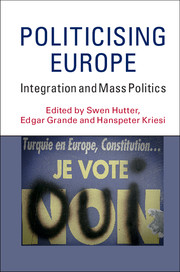Book contents
- Frontmatter
- Contents
- List of figures
- List of tables
- List of contributors
- Preface and acknowledgements
- Part I Theory and methods
- Part II Mapping the politicisation of European integration
- Part III Driving forces and consequences of politicisation
- 6 Constitutive issues as driving forces of politicisation?
- 7 The radical right as driving force in the electoral arena?
- 8 Framing Europe: are cultural-identitarian frames driving politicisation?
- 9 Politicisation, conflicts and the structuring of the EU political space
- 10 The euro crisis: a boost to the politicisation of European integration?
- Part IV Conclusions
- Methodological Appendix: measuring politicisation, benchmarks and data
- Bibliography
- Index
9 - Politicisation, conflicts and the structuring of the EU political space
from Part III - Driving forces and consequences of politicisation
Published online by Cambridge University Press: 05 March 2016
- Frontmatter
- Contents
- List of figures
- List of tables
- List of contributors
- Preface and acknowledgements
- Part I Theory and methods
- Part II Mapping the politicisation of European integration
- Part III Driving forces and consequences of politicisation
- 6 Constitutive issues as driving forces of politicisation?
- 7 The radical right as driving force in the electoral arena?
- 8 Framing Europe: are cultural-identitarian frames driving politicisation?
- 9 Politicisation, conflicts and the structuring of the EU political space
- 10 The euro crisis: a boost to the politicisation of European integration?
- Part IV Conclusions
- Methodological Appendix: measuring politicisation, benchmarks and data
- Bibliography
- Index
Summary
In domestic politics in most developed democracies, political debates are organised along a very small number of dominant dimensions, sometimes even just a single left–right dimension (Kitschelt 1994; Kriesi et al. 2008; Enyedi and Deegan-Krause 2010) and the established actors take more or less stable positions within this political space. Bartolini (2005) and Ferrera (2006) refer to this condition as ‘structuring’. Structure in their understanding is the result of a process whereby political conflicts become institutionalised in the sense that actors form stable, routinised patterns of oppositions and coalitions around a limited set of basic conflicts.
Whether such structure also exists in debates on European integration and the form it takes is an open empirical question that we address in this chapter. In particular, we examine the structuring hypothesis as formulated in the first chapter. This holds that politicisation leads to structuring of political contestation over European integration. Thus, the chapter changes the direction of causal explanation. We no longer focus on the factors leading to high levels of politicisation, but now continue to study the consequences of politicisation. More specifically, we address the structuring hypothesis by asking four key questions. Are debates on European integration structured by a limited number of dimensions? If so, which conflicts are reflected in these dimensions? Within this space, what are the dominant actor constellations? And finally, does clarity of structure increase with levels of politicisation?
Existing studies provide mixed answers to these questions. Studies focusing on national party competition (Hix 1999; Pennings 2002; Hooghe et al. 2004; Kriesi et al. 2012; Wendler 2013), on the European Parliament (Hix et al. 2003; Gabel and Hix 2004; Thomassen et al. 2004; Hix et al. 2006; McElroy and Benoit 2007; Proksch and Slapin 2010; Benoit and Laver 2012; Costello et al. 2012), on the Council of Ministers or the European Council (Haas 1964; Moravcsik 1998; Mattila 2004; Zimmer et al. 2005; Hagemann and Hoyland 2008; Bailer 2011; Veen 2011), on the European Commission (Egeberg 2006; Wonka 2008), on public opinion (Gabel and Anderson 2004; Bornschier 2011) and on several of these arenas at the same time (Selck 2004; Kaeding and Selck 2005; Lindberg et al. 2008; Warntjen et al. 2008) have arrived at quite contradictory conclusions with respect to the structure of conflicts about European integration.
- Type
- Chapter
- Information
- Politicising EuropeIntegration and Mass Politics, pp. 207 - 239Publisher: Cambridge University PressPrint publication year: 2016
- 6
- Cited by



